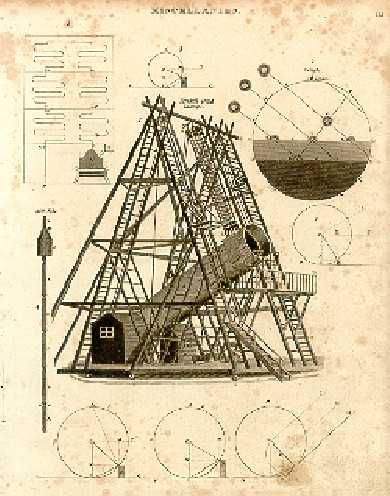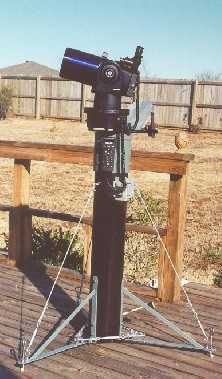HERSCHEL'S "ETX-40"
Last updated: 20 March 2001
HERSCHEL'S "ETX-40" |
Everywhere you look, the GO TO computerized telescope revolution has taken over. Is the Polar Mounting a thing of the past? Indeed, the modern telescopes by Meade, Celestron and others that are driven by computers with 13,000, 32,000 and even nearly 70,000 objects held in a tiny command center data base are ALL designed with one thing in mind: simplicity.
So how does such an electronic and technological marvel rate as "simple?" It is in the mounting. The clear principal that you can drive a telescope in AZIMUTH (horizontal or left-to-right) and ALTITUDE (vertical or up-and-down) nearly as accurately as in a "equatorial polar" arrangement first started gaining popularity when the Russians (actually the now-nearly-forgotten "Soviets") decided that the then-largest telescope in the world - the huge 236-incher - was TOO large for a conventional equatorial mounting and no fork mount could ever stand the incredible torque required to tilt the fork arms toward "north" at the latitude in the Caucasus Mountains!
So they mounted it alt-azimuth, just like the old Unitron refractors that were around when we were kids. Up and down, and side to side with little micrometric slow motion controls! Except for the monster 236" reflector, it wasn't micrometric slow motions....it was state-of-the-art MICROPROCESSORS and encoders that allow tiny, tiny increments of stair stepping to give the SAME EFFECT as an arc across the sky, thereby resulting in very accurate sidereal tracking WITHOUT an equatorial mounting.
Of course, not to be outdone....Meade Instruments picked up on this. Anything the Soviets could do, Meade could do better. And by the tens of thousands. Thus our wonderful world of "GO TO" telescopes was hatched.
But the Soviet 236 incher nor the Meade ETX was the world's FIRST alt-azimuth driven GO TO telescope of merit....not by a long shot!
---------------------------------
SIR WILLIAM HERSCHEL AND HIS "ETX 40-FOOT"
Born in 1738 and trained as a musician, one of the world's foremost astronomers of all times - and the discoverer of the planet Uranus as well as many deep sky celestial wonders - Sir William Herschel at one time had the most magnificent telescope in the world....a "40-foot" wooden telescope that was just as inspiring to look AT as it was to look THROUGH. Some people say that about our modern computerized amateur telescopes today!
Seen here is am 1811 woodcut from my library of the Great Telescope as it was called. This rare original print is from the Proceedings of the Royal Astronomical Society from that year describing the magnificent discoveries of Herschel in his lifetime. It is rare in that it shows (in the upper LEFT corner) the configuration of the actual MOVEMENTS necessary for Herschel's assistants to keep the telescope trained on any celestial object.

Note that this image was scanned through a gas-filled glass protection frame and a lot of finer detail of this near-mint print is not seen.
Nonetheless, does this motion seem familiar to you? It should.....as the diagram at upper left draws out small increments of motion to the right, then up, then left and up again, you must realize that this is EXACTLY the principle on which the Alt-Azimuth GO TO telescopes operate today!
God help Herschel's assistant who would be perched in isolation in the small wooden assistant's hut below the telescope; this poor soul was required to turn hand wheels, pull ropes and manually push levers to maintain the telescope as it tracked through the long hours of morning. Indeed, Herschel's elaborate observatory appears more like a hangman's gallows than a scientific station, with all its ropes, pulleys, and wooden timbers. Even the telescope TUBE is made of wood!
As can be seen, Herschel would stand directly IN FRONT of the telescope opening to observe in the long scaffolding seen at right and merely peer down at the large 40" mirror made of heavy metal, not glass.
To keep accurate time for the tracking, the ticking of a large pendulum-driven clock was used to "pulse" signals to the assistant as small increments in combinations of altitude and azimuth were moved at each beat of the clock.
--------------------------------
CUTTING EDGE TECHNOLOGY
Herschel's telescope was close to a "wonder of the world" in the late 1700's as discovery-upon-discovery was made with this huge instrument. The mechanics of the mounting were a topic of much conversation throughout the scientific and engineering worlds, a marvel of modern technology.
 TODAY'S WONDER OF THE WORLD - THE COMPUTERIZED ETX TELESCOPE
TODAY'S WONDER OF THE WORLD - THE COMPUTERIZED ETX TELESCOPE
Today, sitting in the "small wooden hut" is NOT an over-worked assistant moving levers, ropes and wheels. It is a microprocessor sending signals to tiny encoders and motors that have taken the place of the huge gallows support Herschel's telescope. Perhaps Herschel's eye has now been replaced by a sophisticated CCD camera as you ready the telescope to "shoot" Jupiter tonight.
Power to the telescope does not come from pulling on a rope, but from small batteries that move the GO TO telescope just as precisely as the huge 236-inch soviet mammoth and small, lightweight tripods have replaced Herschel's great timbers that supported his ETX 40-ft.
Even with all of these cutting edge changes in technology, the PRINCIPLE is still the same. Your computerized GO TO telescope has roots very deep in early modern astronomical science.
I only wonder if William Herschel's telescope was BLUE??
P. Clay Sherrod
Arkansas Sky Observatory
Conway / Petit Jean Mountain
Arkansas
Return to the top of this page.
Go back to the Just for Fun page.
Go back to my ETX Home Page.